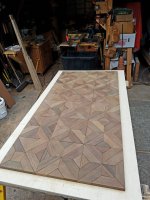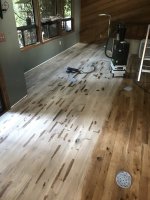ear3
Member
- Joined
- Jul 24, 2014
- Messages
- 4,341
I'm doing a desk for my new office, and am utilizing a tile pattern made from Ipe off cuts like I did for a series of tables for a Japanese restaurant over the winter. With those, I found that wood movement ended up cracking the wood filler I initially used, so I switched over to a more flexible sealer type filler. This eventually did the trick, but it took a bunch of applications to achieve.
This time around I chamfered all the tiles to get an even "grout" line. I'm also not going to screw around with filler, and am using the west system epoxy. I haven't decided whether I will add color or just keep it clear, but I'm wondering what are some good products to dye the filler with.
I experimented with a couple of powders I got off amazon, but haven't been happy so far with the results. I even tried mixing in some fine ipe sawdust, but found that clogged the syringe I have to use in a couple of spots to get the filler all the way in the crack.
Any advice would be appreciated.
This time around I chamfered all the tiles to get an even "grout" line. I'm also not going to screw around with filler, and am using the west system epoxy. I haven't decided whether I will add color or just keep it clear, but I'm wondering what are some good products to dye the filler with.
I experimented with a couple of powders I got off amazon, but haven't been happy so far with the results. I even tried mixing in some fine ipe sawdust, but found that clogged the syringe I have to use in a couple of spots to get the filler all the way in the crack.
Any advice would be appreciated.



